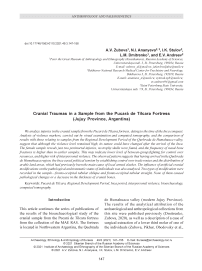Cranial traumas in a sample from the Pucar'a de Tilcara fortress (Jujuy province, Argentina)
Автор: Zubova A.V., Dmitrenko L.M., Ananyeva N.I., Stulov I.K., Andreev E.V.
Журнал: Archaeology, Ethnology & Anthropology of Eurasia @journal-aeae-en
Рубрика: Anthropology and paleogenetics
Статья в выпуске: 3 т.49, 2021 года.
Бесплатный доступ
We analyze injuries in the cranial sample from the Pucará de Tilcara fortress, dating to the time of the Inca conquest. Analysis of violence markers, carried out by visual examination and computed tomography, and the comparison of results with those relating to samples from the Regional Development Period of the Quebrada de Humahuaca valley, suggest that although the violence level remained high, its nature could have changed after the arrival of the Inca. The female sample reveals just two perimortal injuries, no trophy skulls were found, and the frequency of nasal bone fractures is higher than in earlier samples. This may indicate lower level of between-group fi ghting for control over resources, and higher risk of interpersonal violence. The observed pattern suggests that having arrived in the Quebrada de Humahuaca region, the Inca eased political tension by establishing control over trade routes and the distribution of arable land areas, which had previously been the main cause of local armed clashes. The infl uence of artifi cial cranial modifi cations on the pathological and traumatic status of individuals was also analyzed. Two types of modifi cation were recorded in the sample—fronto-occipital tabular oblique and fronto-occipital tabular straight. None of them caused pathological changes or a decrease in the thickness of cranial bones.
Pucará de Tilcara, Regional Development Period, Inca period, interpersonal violence, bioarchaeology, computed tomography
Короткий адрес: https://sciup.org/145146294
IDR: 145146294 | DOI: 10.17746/1563-0110.2021.49.3.147-156
Список литературы Cranial traumas in a sample from the Pucar'a de Tilcara fortress (Jujuy province, Argentina)
- Borodovsky A.P., Zubova A.V., Pozdnyakov D.V., Tabarev A.V., Cheremisin D.V. 2010 Arkheologiya nasiliya (interpretatsiya materialov arkheologicheskikh, antropologicheskikh i izobrazitelnykh kompleksov): Ucheb.-metod. posobiye. Novosibirsk: Novosib. Gos. Univ.
- Dmitrenko L.M., Zubova A.V. 2020 Collection related to the Omaguaca Indians from the Pucará de Tilcara Fortress, Northwestern Argentina, at the Museum of Anthropology and Ethnography RAS, St. Petersburg: Tentative Findings. Archaeology, Ethnology and Anthropology of Eurasia, vol. 48 (1): 149-157.
- Greco C., Otero C. 2015 The chronology of settlements with pre-inca and inca occupations superimposed: The case of Pucará de Tilcara (Humahuaca Gorge, Argentina). Archaeometry, vol. 58 (5): 848-862.
- Handbook of South American Indians. 1946 Vol. 2: The Andean Civilizations. Washington: Government Printing Office, 1946. (Smithsonian Institution Bureau of American Ethnology; bull. 143).
- Mahinda H., Murty O.P. 2009 Variability in thickness of human skull bones and sternum- an autopsy experience. Journal of Forensic Medicine, vol. 26 (2): 26-31.
- Marino R., Gonzales-Portillo M. 2000 Pre-conquest Peruvian neurosurgeons: A study of Inca and pre-Columbian trephination and the art of medicine in ancient Peru. Neurosurgery, iss. 47: 940-950.
- Otero C. 2013 La arqueología en el relato ofi cial del estado nacional: El caso Del Pucará de Tilcara (Jujuy, Argentina). Arqueología Suramericana/Arqueología Sul-Americana, vol. 6 (1/2): 87-111.
- Pererva E.V. 2015 Rentgenologicheskoye issledovaniye deformirovannykh cherepov zolotoordynskogo vremeni s territorii Nizhnego Povolzhya (paleoliticheskiy aspect). Vestnik arkheologii, antropologii i etnografi i, No. 2: 98-114.
- Pérez Pieroni M.J., Becerra M.F. 2018 Archaeology of Northwestern Argentinean Puna. In Encyclopedia of Global Archaeology, C. Smith (ed.). New York: Springer.
- Plitnichenko B.G., Telkov V.E. 2011 Anatomicheskiye osobennosti tolshchiny kostey cherepa u zhiteley Tulskoy oblasti i vliyaniye ikh na obrazovaniye perelomov. Vestnik novykh meditsinskikh tekhnologiy, vol. XVIII (3): 314-316.
- Seldes V., Botta F.N. 2014 Violence indicators in Quebrada de Humahuaca, Jujuy, Argentina: The Regional Development Period from a regional perspective. Anthropological Review, vol. 77 (1): 87-109.
- Sprovieri M. 2013 El mundo en movimiento: Circulación de bienes, recursos e ideas en el valle Calchaquí, Salta (Noroeste Argentino): Una vision desde La Paya. Oxford: Archaeopress. (BAR Int. Ser.; No. 2487).
- Thulung S., Ranabhat K., Bishokarma S., Gongal D.N. 2019 Morphometric measurement of cranial vault thickness: A Tertiary hospital based study. Journal of Nepal Medical Association, vol. 57 (215): 29-32.
- Zaburlín M.A. 2009 Historia de ocupación del Pucará de Tilcara (Jujuy, Argentina). Intersecciones en Antropología, vol. 10 (1): 89-103.
- Zaburlín M.A., Otero C. 2014 Un manuscrito olvidado de J.B. Ambrosetti: “Exploraciones arqueológicas en la Antigua ciudad del Pukará de Tilcara”. In Investigaciones del Instituto Interdisciplinario Tilcara. Buenos Aires: Editorial de la Facultad de Filosofia y Letras, pp. 161-220.
- Zubova A.V., Ananyeva N.I., Moiseyev V.G., Stulov I.K., Dmitrenko L.M., Obodovsky A.V., Potrakhov N.N., Kulkov A.M., Andreev E.V. 2020 The use of computed tomography for the study of chronic maxillary sinusitis: Based on crania from the Pucará De Tilcara Fortress, Argentina. Archaeology, Ethnology and Anthropology of Eurasia, vol. 48 (3): 143-153.
- Zubova A.V., Pikhur O.L., Obodovskiy A.V., Malyutina A.A., Dmitrenko L.M., Chugunova K.S., Pozdnyakov D.V., Bessonov V.B. 2020 A case of surgical extraction of the lower third molars in a cranial series from the Pucará de Tilcara Fortress (Jujuy Province, Argentina). Archaeology, Ethnology and Anthropology of Eurasia, vol. 48 (2): 149-156.


